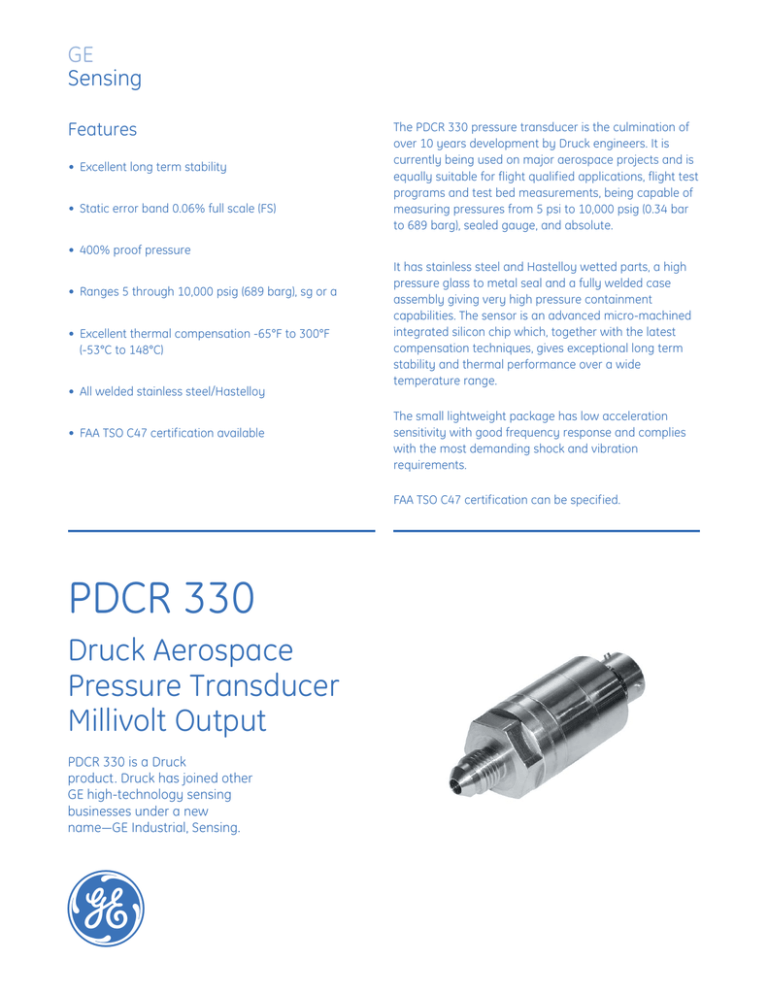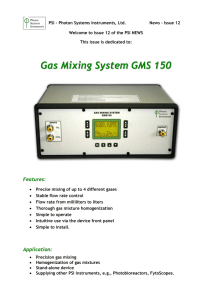
GE
Sensing
Features
• Excellent long term stability
• Static error band 0.06% full scale (FS)
The PDCR 330 pressure transducer is the culmination of
over 10 years development by Druck engineers. It is
currently being used on major aerospace projects and is
equally suitable for flight qualified applications, flight test
programs and test bed measurements, being capable of
measuring pressures from 5 psi to 10,000 psig (0.34 bar
to 689 barg), sealed gauge, and absolute.
• 400% proof pressure
• Ranges 5 through 10,000 psig (689 barg), sg or a
• Excellent thermal compensation -65°F to 300°F
(-53°C to 148°C)
• All welded stainless steel/Hastelloy
• FAA TSO C47 certification available
It has stainless steel and Hastelloy wetted parts, a high
pressure glass to metal seal and a fully welded case
assembly giving very high pressure containment
capabilities. The sensor is an advanced micro-machined
integrated silicon chip which, together with the latest
compensation techniques, gives exceptional long term
stability and thermal performance over a wide
temperature range.
The small lightweight package has low acceleration
sensitivity with good frequency response and complies
with the most demanding shock and vibration
requirements.
FAA TSO C47 certification can be specified.
PDCR 330
Druck Aerospace
Pressure Transducer
Millivolt Output
PDCR 330 is a Druck
product. Druck has joined other
GE high-technology sensing
businesses under a new
name—GE Industrial, Sensing.
g
GE
Sensing
PDCR 330
Standard
Specifications
Operating Pressure Ranges
5, 10, 15, 20, 30, 50, 75, 100, 150, 200, 300, 500, 900 and
1000 psig (0.34, 0.68, 1.03, 2.06, 3.44, 6.89, 10.34, 20.68,
34.47, 62, 68 barg) or absolute.
2000, 3000, 5000, 7500 and 10,000 psig (137, 206, 344,
689 barg) or absolute.
Other pressure units can be specif ied, for example, bar,
kPa.
For flight qualified applications any FS pressure range
between 5 and 10,000 psi (0.34 and 6890 bar) can be
specified.
Proof Pressure
The rated pressure can be exceeded by the following
without calibration change.
• 4X FS or 2000 psi (137 bar) whichever is less for ranges
up to 1000 psi (68 bar).
• 2X FS or 20000 psi (1378 bar). whichever is less for
ranges 2000 psi to 10000 psi (689 bar).
Secondary Containment
The transducers will contain without leakage:
2000 psi (137 bar): Absolute ranges up to 1000 psi
20000 psi (1378 bar): Sealed gauge and absolute units for
ranges 2000 psi to 10,000 psi (137 bar to 689 bar).
Positive Pressure Media
Fluids/gases compatible with Stainless Steel 316 L and
Hastelloy.
Excitation Voltage
10 VDC regulated
Other regulated dc excitation levels can be specif ied, for
example, 5 VDC giving 50 mV output span etc.
For non regulated excitation (proportional output) contact
the manufacturer.
Output Voltage
50 mV for 5 psi (0.34 bar) range
100 mV for 10 psi (0.68 bar) range and above.
Other output sensitivities can be specified, for example,
between 20 mV and 200 mV FS for most pressure ranges.
Common Mode Voltage
Typically 5 V to 8.5 V with respect to the negative supply
at 10 VDC excitation
Output Impedance
2000 Ω nominal (5000 Ω available, consult factory)
Static Error Band
Combined Non-linearity, Hysteresis and Repeatability
• ±0.1% base standard line (BSL) for ranges up to 900 psi
• ±0.2% BSL for 1000 psi (68.9 bar)
• ±0.75% BSL for 2000 to 10,000 psi (137 to 689 bar)
• Typical values: (For all ranges)
• Hysteresis: ±0.02% FS
• Repeatability: ±0.02% FS
±0.06% BSL for ranges up to 300 psi available to order.
±0.1% BSL available for ranges 1000 psi (68.9 bar) and
above, refer to manufacturer.
Zero Offset and Span Setting
±3 mV maximum
More accurate settings to ±1 mV are available where interchangeability is important.
Operating Temperature Range
-65°F to 300°F (-54°C to 150°C)
Temperature Effects
Thermal Error Band (TEB) or average coefficients (% FS/°F)
including thermal zero shift, sensitivity shift and the
thermal hysteresis.
• 32°F to 122°F
±0.3% TEB
(0°C to 50°C)
(±0.003% FS/°F)
• -40°F to 175°F
±1.0% TEB
(-40°C to 79°C)
(±0.004% FS/°F)
• -65°F to 250°F
±1.5% TEB
(-53°C to 121°C) (±0.005% FS/°F)
• -65°F to 300°F
±2.5% TEB
(-54°C to 148°C) (±0.007% FS/°F)
GE
Sensing
PDCR 330
Standard
Specifications
Long Term Stability
Typically ±0.1% FS
Humidity, Fungus Resistance, Salt, Fog, Sand and Dust
Compatible with MIL-STD-810 or DO-160 requirements.
Acceleration Sensitivity
Typically 0.02% FS/g for 5 psi (0.34 bar) decreasing to
0.0003% FS/g for ranges above 900 psi, along the
sensitive axis.
Mechanical Shock
1000 g 1 ms half sine pulse in each of 3 mutually
perpendicular axes will not affect performance.
Pressure Connection
7/16 in UNF thread incorporating 0.12 in (3.05 mm)
through bore generally to MS33656-4.
Alternative pressure connections available to order.
Weight
4.0 oz. nominal
Options
(1) ‘R’ cal by specified external resistor to give nominal
75% change in output available.
(2) Ranges below 5 psi (0.34 bar).
(3) Differential pressure measurement.
(4) Amplified output transducers to operate from
16 to 32 VDC excitation. (PMP 3000)
Please refer to the manufacturer for further information
and data sheets.
1.0 in
(25.4 mm)
0.86 in
(21.84 mm)
Typical Electrical Connection
Pin A
Supply positive
Pin B
Output positive
Pin C
Output negative
Pin D
Supply negative
Natural Frequency
Greater than 10.5 kHz for 5 psi (0.34 bar) increasing to
210 kHz for 500 psi (34.4 bar) ranges and above.
Vibration
Response less than 0.05% FS/g at 30 g peak 10Hz--2kHz,
limited by 0.5 in (12.7 mm) double amplitude.
(MIL-STD-810C Proc 514.2-2 Curve L).
0.55 in
(13.97 mm)
2.75 in
(69.85 mm)
Electrical Connection
Six pin bayonet fixed plug per MIL-C-26482
Many alternates available
Mating socket not supplied but available to order. Size 8,
four-pin electrical connection or integral cable assembly
available.
Installation Drawings
GE
Sensing
g
©2006 GE All rights reserved.
920-215A
All specifications are subject to change for product improvement without notice.
GE® is a registered trademark of General Electric Co. Other company or product
names mentioned in this document may be trademarks or registered trademarks
of their respective companies, which are not affiliated with GE.
www.gesensing.com




